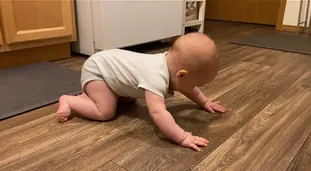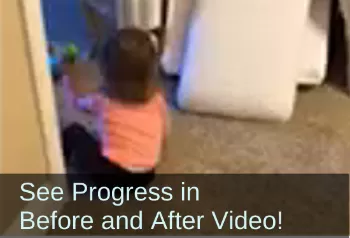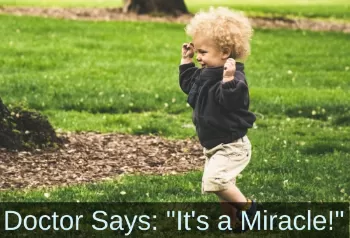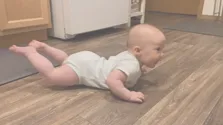Sonia’s Insights: Deep Dive into Development
Crawling: A Milestone Worth Meeting
Benefits and Shortcomings of Crawling Programs—3 Recommendations to Support Optimal Crawling
Many parents and professionals are aware of the important role crawling plays in development. But when a child lacks a strong neurodevelopmental foundation, are crawling programs helpful or not?
by Sonia Story, M.S.
Like most of what we see in creation and the natural world, human development is a beautiful, intelligent, complex, and synergistic system where everything has a purpose and everything supports the unfolding of the next part of the process.
It seems very likely that we can trust in the rightness of healthy human development, and that the innate process of crawling—on the belly and on hands and knees—exists for important reasons. While human beings can survive and function without crawling, most parents and experts in human development understand that crawling is an essential part of the process in order to function optimally in infancy and beyond.
When children have skipped crawling—or if they exhibited abnormal locomotion in infancy—then it will likely be very helpful for them to crawl to overcome some of the gaps in their development. However, in order to crawl properly, there needs to be a good neuro-sensory-motor foundation in place. Below are three important recommendations to help make crawling easier, more enjoyable, and more beneficial. First we will look at some interesting research on crawling, plus a rant about crawling from an experienced pediatric therapist.
 Research on the Benefits of Crawling
Research on the Benefits of Crawling
There are many research studies that support the benefits of crawling:
- Cazorla-González et al. (2022) did follow up measurements at age 7 of children who crawled before walking and those who did not crawl before walking. The children who crawled before walking had lower fat mass and higher levels of muscle mass than non-crawlers. The children who crawled in infancy also had lower systolic blood pressure than those who skipped crawling. The researchers concluded that crawling before walking may positively impact future overall health (Cazorla-González et al., 2022).
- Researchers studying 9-month-old infants showed that those who crawled had better cognitive abilities, such as more flexible memory retrieval skills (Herbert et al., 2007) and mental rotation ability (Schwarzer et al., 2013).
- This research showed that infants with greater experience in crawling did better than novice crawlers in a spatial memory task: “…we know that crawling experience serves as a mediator of cognitive skills and that both the onset of crawling and crawling experience affect spatial memory” (Clearfield, 2004, p. 219).
- When studying motor skills in preschoolers, McEwan et al. (1991) found that the influence of crawling in infancy was shown to be beneficial to motor skill development. The preschoolers who were noncrawlers in infancy scored significantly lower in motor skills tests than those children who had crawled (McEwan et al., 1991).
- Hernández-Martínez et al. (2023) found that 5-year-old children who had achieved crawling in infancy showed significantly better motor competence than those who had not crawled in infancy.
- The experiences concurrent with crawling “provide a foundation for visual-spatial perception [and]… The process of crawling provides a state of eye-hand coordination, vestibular processing, improvement of balance and equilibrium, spatial awareness, tactile input, kinesthetic awareness, and social maturation” (McKewan et al., 1991, p. 75).
- On tests of visual perception in a group of children between the ages of 5 and 6, those who had crawled in infancy performed significantly better than those children who did not crawl in infancy; the crawling children also showed a more efficient ability to grasp a pencil (Visser & Franzsen, 2010).
- Crawling appears to be associated with building emotional discrimination skills; for example, infants who had more experience crawling appeared to be more sensitive to detecting emotion in facial expressions than the same-aged noncrawling children (Gehb et al., 2022).
- Crawling intervention helped children with ASD (ages 7-19) to improve fine-motor skills (Stewart, 2014).
Some argue that the research on crawling is not definitive. That may be partly true because it is hard to separate the benefits of crawling from the benefits of achieving independent mobility. And most of us have come across individuals who never crawled, but who appear to be functioning quite well despite the lack of crawling.
However, I agree with the vast majority of pediatric physical therapists who, in a recent survey, said they believed that crawling was important (92%) and linked to positive developmental outcomes (71%-99%). One therapist in the survey explained, “I have noticed a trend that my children that skipped crawling tend to have a weaker core, weaker upper extremities, sometimes weaker [lower extremities], decreased bilateral coordination and frequently may have asymmetrical or atypical gross motor skills” (Kretch et al., 2024, p. 11). Another therapist wrote: “The school age students that I work with who skipped crawling typically struggle...with coordination, speech, and academics, especially reading” (Kretch et al., 2024, p. 11).
In the same survey, a large majority of pediatric physical therapists (79%) disagreed with the removal of crawling from the CDC developmental checklists (Kretch et al., 2024).
A Rant—Pediatric Therapist Speaks Out
During an email conversation, this highly experienced pediatric therapist wrote to me about her opinion regarding the removal of crawling from the CDC guidelines.
“This topic is really a hot button issue for me, so I apologize in advance for the tirade. Due to insurance companies dictating how doctors practice, they use the stupid, illogical, ridiculous CDC developmental guidelines as what they will and won’t pay for. The insurance carriers don’t pay for “unnecessary services”, i.e. if the CDC guidelines don’t include developmental steps, such as army crawling, then they typically won’t pay for therapy concerning that isolated skill. There have to be global concerns. Therefore the doctors start getting concerned if the child isn’t walking by the time they graduate from high school. Yes, I am frustrated with the system and that was an overstatement, but the CDC has really downplayed a LOT of developmental steps plus they have really increased the age at which they expect children to reach specific skills resulting in doctors being VERY nonchalant about many developmental skills. It absolutely makes my blood boil. I went to the head of the Infant Toddler Program here and tried to get them to advocate for the children of my state and push back against the CDC new guidelines, but I got absolutely nowhere with my concerns.
Here are some examples of my concerns:
• They don’t expect a child to sit alone until 9 months. (I say no later than 7 months).
• There are NO crawling skills whatsoever in these guidelines—which gives the impression that army crawling and 4-point crawling are not important to a child’s development.
• They don’t expect a child to take a couple steps until they are 15 months.
• Independent walking is expected by 18 months. That is ridiculously late!
Here’s an example of a concern that I am convinced will play out in the years ahead. A child is not walking at 18 months but they don’t have a checkup with the doctor until the 24 month-old appointment. So they go to the doctor at 24 months and they are not walking yet. Therapy could have started 12 months previously and probably prevented other issues that often develop concurrently with this kind of delay. To me it is child abuse.“
Knowing what you know about development, can you relate to this therapist’s message? I appreciate her well-informed perspective and that she is advocating for children and the importance of early intervention here!
3 Recommendations Before Starting a Crawling Program
To develop optimal crawling and get the most benefit from it, here are my three recommendations on crawling:
Recommendation 1: In order to crawl properly a good neuro-sensory-motor foundation should be in place. The best way I know of build a solid neuro-sensory-motor foundation is to start with rhythmic movements, and then add in comprehensive primitive reflex integration. Think about how babies develop—it takes months of extensive movement in early life for an infant to build up to the ability to crawl—either on the belly or on hands-and-knees. Recent research showed that poor integration of primitive reflexes was associated with an inability to develop crawling and led to poor motor competence as the child reached school-age (Hernández-Martínez et al., 2023). Other research shows that integrating primitive reflexes leads to improved crawling in children between the ages of 4 to 7 (Infante-Cañete et al., 2023).
Here is a stunning example of how primitive reflex integration and rhythmic movements are powerful for helping a delayed child, who at 22 months scooted on her bottom as her only means of locomotion.  This child quickly learned to crawl and then walk. In another
This child quickly learned to crawl and then walk. In another  remarkable example, the pediatrician of a premature infant predicted this boy would never walk without aid. This boy walked without aid at the age of 18 months—after only 3 months of intervention with rhythmic movements and primitive reflex integration.
remarkable example, the pediatrician of a premature infant predicted this boy would never walk without aid. This boy walked without aid at the age of 18 months—after only 3 months of intervention with rhythmic movements and primitive reflex integration.
In the Brain and Sensory Foundations course, we have a step-by-step process for replicating natural development as closely as possible, so that the child is able to crawl comfortably and well from a strong core—and with alignment, symmetry, coordination, and the least amount of effort. If we provide a child with a good foundation, crawling will be much easier, more enjoyable, and more effective. If we do not take the time to build this foundation, then the child’s body will likely be weak with underlying tension while crawling. The child may skip crawling altogether, or the child may crawl with compensatory movement patterns and misalignment. When there is a lack of a strong foundation, many children will resist crawling because it is too hard. So if you are going to crawl with children, take the time to build the foundation with innate rhythmic movements and primitive reflex integration!
 Recommendation 2: Before embarking on a crawling program, a second area of development I recommend doing is to build the ability for prone activities. Being in prone—on the belly—for extended periods of time is vitally important to the ability to crawl. Before 1994 when the “Back to Sleep” campaign began, most parents would intuitively place babies on their bellies for sleep. This provided infants with many hours a day in prone, a position that contributes greatly to building core strength and readiness for crawling. When infants or young children are not able to comfortably spend time on the belly, it is usually because they missed building their core strength with time in prone from birth and through infancy. As a child grows, it can be more difficult to be in prone if the initial foundation from early infancy is absent. When being on the belly is hard for the child, we can build tolerance for prone activities gradually and speed up the process by using rhythmic movements and primitive reflex integration—see this boy's huge gains in core strength as an example. Get more information about the importance of time on the belly for building the foundation for core strength and crawling.
Recommendation 2: Before embarking on a crawling program, a second area of development I recommend doing is to build the ability for prone activities. Being in prone—on the belly—for extended periods of time is vitally important to the ability to crawl. Before 1994 when the “Back to Sleep” campaign began, most parents would intuitively place babies on their bellies for sleep. This provided infants with many hours a day in prone, a position that contributes greatly to building core strength and readiness for crawling. When infants or young children are not able to comfortably spend time on the belly, it is usually because they missed building their core strength with time in prone from birth and through infancy. As a child grows, it can be more difficult to be in prone if the initial foundation from early infancy is absent. When being on the belly is hard for the child, we can build tolerance for prone activities gradually and speed up the process by using rhythmic movements and primitive reflex integration—see this boy's huge gains in core strength as an example. Get more information about the importance of time on the belly for building the foundation for core strength and crawling.
Recommendation 3: While crawling is important, the previous two recommendations will hopefully make it clear why I am opposed to programs that prescribe extensive crawling for children—without a proper foundation in place. I have heard from many dismayed parents who were trying to help their children with such programs. Parents were told their children must crawl for a time span of 40 minutes in order for the program to work. I recommend staying away from long periods of continuous crawling unless the child is enjoying it, wants to crawl for that length of time, and can already crawl with symmetry, strength, and without compensatory movement patterns. While extensive crawling programs are well-meaning, and they may help some children, there is often a negative cost. The parents I spoke with were distressed because they were arguing with their children to try to get them to crawl each day—the children were refusing to crawl and there was tension and fighting between parent and child. I believe we do children a disservice in situations like these. We should always strive to structure our movement programs so they are safe, easy, and enjoyable. From there we can engage a child to do more. And if we think about crawling for children, it is good to consider the natural development of healthy infants again because that is what makes the most sense to follow. In actual development, children crawl and stop to engage in an object of interest. They crawl and stop, crawl and stop, crawl and stop. We do not see infants crawling continuously for 40 minutes.
A final note: Once a good foundation is built for crawling, I would recommend crawling for all ages—toddlers, children, teens, and adults. Have fun!
Let me know if this article was helpful and please share your tips for fun ways to crawl with children. I trust by following these recommendations, you can maximize the benefits of crawling while helping children to move with symmetry, alignment, flow, coordination, and fun!
References
Clearfield, M. W. (2004). The role of crawling and walking experience in infant spatial memory. Journal of experimental child psychology, 89(3), 214-241.
Gehb, G., Vesker, M., Jovanovic, B., Bahn, D., Kauschke, C., & Schwarzer, G. (2022). The relationship between crawling and emotion discrimination in 9-to 10-Month-Old infants. Brain Sciences, 12(4), 479.
Herbert, J., Gross, J., Hayne, H. (2007). Crawling is associated with more flexible memory retrieval by 9-month-old infants. Developmental Science, 10(2), 183-189.
Hernández-Martínez, A., Sánchez-Matas, Y., Gutiérrez, D., & Exposito, L. (2023). Relationships among integration of Primitive reflexes, Motor competence and Crawling in children. Authorea Preprints.
Infante-Cañete, L., Aguilar-Guerrero, B., & Wallace-Ruiz, A. (2023). Effect of a psychoeducational intervention on motor and perceptual-visual development through the inhibition of primitive reflexes in schoolchildren aged 4 to 7 years old. Revista de Psicodidáctica (English ed.), 28(2), 182-189.
Kretch, K. S., Dusing, S. C., Harbourne, R. T., Hsu, L. Y., Sargent, B. A., & Willett, S. L. (2024). Early mobility and crawling: beliefs and practices of pediatric physical therapists in the United States. Pediatric Physical Therapy, 36(1), 9-17.
McEwan, M. H., Dihoff, R. E., & Brosvic, G. M. (1991). Early infant crawling experience is reflected in later motor skill development. Perceptual and motor skills, 72(1), 75-79.
Stewart K. L. (2014). Crawling pattern movement effects on fine motor skills among children with autism spectrum disorder. [Published master’s thesis, Missouri State University].
Visser, M. M., & Franzsen, D. (2010). The association of an omitted crawling milestone with pencil grasp and control in five-and six-year-old children. South African Journal of Occupational Therapy, 40(2), 19-23.
Sonia Story, M.S. has been teaching neurodevelopmental movements since 2006.
Sonia developed the Brain and Sensory Foundations program to provide comprehensive training in neurodevelopmental movements—combining innate rhythmic movements, play, primitive reflexes, and postural reflexes.
She earned a Bachelor's degree in biology/psychology and a Master’s degree in Movement Sciences. She is the author of The Importance of Reflex Integration and the Evidence eBook, giving the rationale and evidence basis for using neurodevelopmental movements for helping with challenges such as ADHD, Sensory Processing Disorders, anxiety, emotional dysregulation, visual skill deficits, poor social skills, gross and fine motor delays and other neurodevelopmental and behavioral disorders.
Her work is featured in numerous podcasts, summits, and conferences, and in the books Almost Autism: Recovering Children from Sensory Processing Disorder; Special Ed Mom Survival Guide; Family Health Revolution; and Same Journey, Different Paths—Stories of Auditory Processing Disorder.
Sonia’s mission is to help children and families experience the profound benefits of neurodevelopmental and integrative movements for more functional and fulfilling lives.


